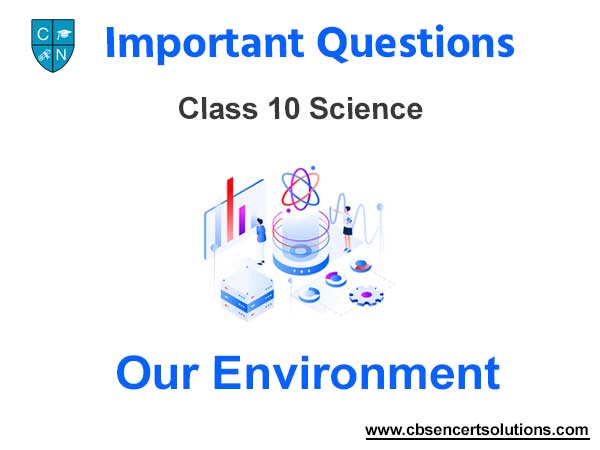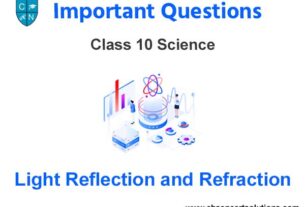Please refer to Chapter 15 Our Environment Case Study Questions with answers provided below. We have provided Case Study Questions for Class 10 Science for all chapters as per CBSE, NCERT and KVS examination guidelines. These case based questions are expected to come in your exams this year. Please practise these case study based Class 10 Science Questions and answers to get more marks in examinations.
Case Study Questions Chapter 15 Our Environment
Case/Passage – 1
Food chains are very important for the survival of most species. When only one element is removed from the food chain it can result in extinction of a species in some cases. The foundation of the food chain consists of primary producers. Primary producers, or autotrophs, can use either solar energy or chemical energy to create complex organic compounds, whereas species at higher trophic levels cannot and so must consume producers or other life that itself consumes producers.
Because the sun’s light is necessary for photosynthesis, most life could not exist if the sun disappeared. Even so, it has recently been discovered that there are some forms of life,
chemotrophs, that appear to gain all their metabolic energy from chemosythesis driven by hydrothermal vents, thus showing that some life may not require solar energy to thrive.
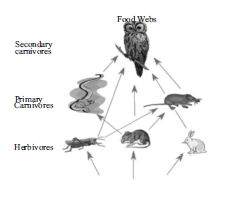
Question: If 10,000 J solar energy falls on green plants in a terrestrial ecosystem, what percentage of solar energy will be converted into food energy?
(a) 10,000 J
(b) 100 J
(c) 1000 J
(d) It will depend on the type of the terrestrial plant.
Answer
B
Question: If Ravi is consuming curd/yogurt for lunch, which trophic level in a food chain he should be considered as occupying ?
(a) First trophic level
(b) Second trophic level
(c) Third trophic level
(d) Fourth trophic level
Answer
C
Question: The decomposers are not included in the food chain.The correct reason for the same is because decomposers:
(a) Act at every trophic level of the food chain
(b) Do not breakdown organic compounds
(c) Convert organic material to inorganic forms
(d) Release enzymes outside their body to convert organic material to inorganic forms
Answer
A
Question: Matter and energy are two fundament al inputs of an ecosystem. Movement of
(a) Energy is bidirectional and matter is repeatedly circulating.
(b) Energy is repeatedly circulation and matter is unidirectional.
(c) Energy is unidirectional and matter is repeatedly circulating.
(d) Energy is multidirectional and matter is bidirectional.
Answer
C
Question: Which of the following limits the number of trophic levels in a food chain?
(a) Decrease in energy at higher trophic levels
(b) Less availability of food
(c) Polluted air
(d) Water
Answer
A
Case/Passage – 2
The diagram below shows a food web from the sea shore
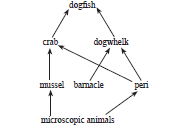
Question: The mussel can be described as
(a) Producer
(b) Primary consumer
(c) Secondary consumer
(d) decomposer
Answer
C
Question: Which trophic level is incorrectly defined?
(a) Carnivores – secondary or tertiary consumers
(b) Decomposers – microbial heterotrophs
(c) Herbivores – primary consumers
(d) Omnivores – molds, yeast and mushrooms
Answer
D
Question: The given figure best represents:
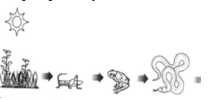
(a) Grassland food chain
(b) Parasitic food chain
(c) Forest food chain
(d) Aquatic food chain
Answer
A
Question: Why do all food chains start with plants?
(a) Because plants are easily grown
(b) Because plants are nutritious
(c) Because plants can produce its own energy
(d) Because plants do not require energy
Answer
C
Question: In the food web, what two organisms are competing for food?

(a) A and B
(c) A and C
(b) D and F
(d) B and D
Answer
D
Question: Consider the following statements concerning food chains:
(i) Removal of 80% tigers from an area resulted in greatly increased growth of vegetation
(ii) Removal of most of the carnivores resulted in an increased population of herbivores.
(iii) The length of the food chains is generally limited to 3 – 4 trophic levels due to energy loss
(iv) The length of the food chains may vary from 2 to 8 trophic levels
Which two of the above statements are correct?
(a) (i), (iv)
(b) (i), (ii)
(c) (ii), (iii)
(d) (iii), (iv)
Answer
C
Question: Which of the following group of organisms are not included in ecological food chain?
(a) Carnivores
(b) Saprophytes
(c) Herbivores
(d) Predators
Answer
B
Case/Passage – 3
Biosphere is a global ecosystem composed of living organisms and abiotic factors from which they derive energy and nutrients.
And ecosystem is defined as structural and functional unit of the biosphere comprising of living and non-living environment that interact by means of food chains and chemical cyclesresulting in energy flow, biotic diversity and material cycling to form a stable, self-supporting system
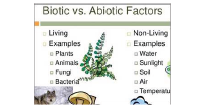
Question: Which trophic level is incorrectly defined?
(a) Carnivores – secondary or tertiary consumers
(b) Decomposers – microbial heterotrophs
(c) Herbivores – primary consumers
(d) Omnivores – molds, yeast and mushrooms
Answer
D
The diagram below shows a food web from the sea shore
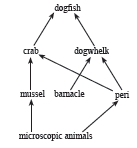
Question: The mussel can be described as
(a) Producer
(b) Primary consumer
(c) Secondary consumer
(d) decomposer
Question: The given figure best represents:

(a) Grassland food chain
(b) Parasitic food chain
(c) Forest food chain
(d) Aquatic food chain
Answer
A
Case/Passage – 4
Food chains are very important for the survival of most species.
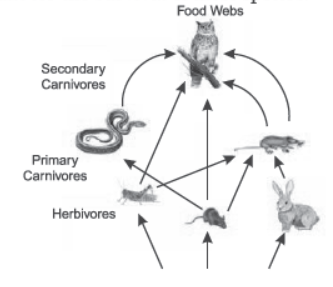
Question. Matter and energy are two fundamental inputs of an ecosystem. Movement of
(a) Energy is bidirectional and matter is repeatedly circulating.
(b) Energy is repeatedly circulation and matter is unidirectional.
(c) Energy is unidirectional and matter is repeatedly circulating.
(d) Energy is multidirectional and matter is bidirectional.
Answer
C
Question. Which of the following limits the number of trophic levels in a food chain?
(a) Decrease in energy at higher trophic levels
(b) Less availability of food
(c) Polluted air
(d) Water
Answer
A
Question. If 10,000 J solar energy falls on green plants in a terrestrial ecosystem, what percentage of solar energy will be converted into food energy?
(a) 10,000 J
(b) 100 J
(c) 1000 J
(d) It will depend on the type of the terrestrial plant.
Answer
B
Question. If Ravi is consuming curd/yogurt for lunch , which trophic level in a food chain he should be considered as occupying ?
(a) First trophic level
(b) Second trophic level
(c) Third trophic level
(d) Fourth trophic level
Answer
C
Question. The decomposers are not included in the food chain.The correct reason for the same is because decomposers:
(a) Act at every trophic level of the food chain
(b) Do not breakdown organic compounds
(c) Convert organic material to inorganic forms
(d) Release enzymes outside their body to convert organic material to inorganic forms
Answer
A
Case/Passage – 5
Observe the following diagram and answer the questions any four from (i) and (v)
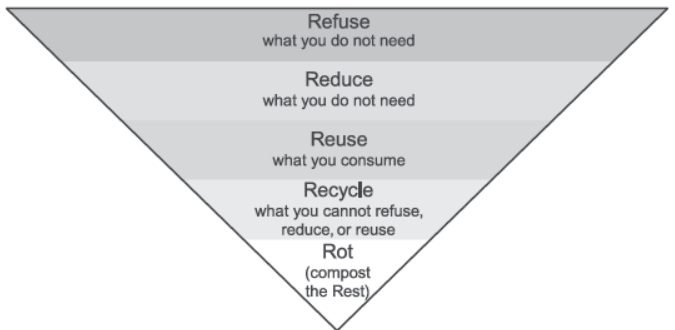
Question. Effective segregation of wastes at the point of generation is very important. Select the appropriate statements giving the importance of waste segregation.
I. less waste goes to the landfills
II. better for public health and the environment
III. help in reducing the waste
IV. resulting in deterioration of a waste picker’s health
(a) both I and II
(b) both I and III
(c) both II and III
(d) both I and IV
Answer
A
Question. The given graph shows the amount of waste generated, dumped and treated in percentage. Identify the reason of low success rate of waste management process.

(a) only 15% of urban India’s waste is processed
(b) less than 60% of waste is collected from households
(c) more than 60% of waste is collected from households
(d) both (a) and (b)
Answer
A
Question. Choose the waste management strategy that is matched with correct example.
(a) Refuse Choose products that use less packaging
(b) Reduce Give unwanted toys and books to hospitals or schools
(c) Reuse Not using single use plastic
(d) Repurpose Making flower pot from used plastic bottle
Answer
D
Question. Recycling of paper is a good practice but recycled paper should not be used as food packaging because
(a) recycled papers may release color /dyes on food items
(b) recycled papers are not absorbent
(c) recycled papers can cause infection due to release of methane
(d) recycled papers are costly
Answer
C
Question. According to the ‘Solid Waste Management Rule 2016’, the waste should be segregated into three categories. Observe the table below and select the row that has correct information

Answer
B
Case/Passage – 6
Biosphere is a global ecosystem composed of living organisms and abiotic factors from which they derive energy and nutrients. And ecosystem is defined as structural and functional unit of the biosphere comprising of living and non-living environment that interact by means of food chains and chemical cycles resulting in energy flow, biotic diversity and material cycling to form a stable, self-supporting system

Question. The given figure best represents:
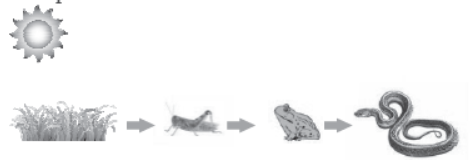
(a) Grassland food chain
(b) Parasitic food chain
(c) Forest food chain
(d) Aquatic food chain
Answer
A
Question. Consider the following statements concerning food chains:
(i) Removal of 80% tigers from an area resulted in greatly increased growth of vegetation
(ii) Removal of most of the carnivores resulted in an increased population of herbivores.
(iii) The length of the food chains is generally limited to 3 – 4 trophic levels due to energy loss
(iv) The length of the food chains may vary from 2 to 8 trophic levels Which two of the above statements are correct?
(a) (i), (iv)
(b) (i), (ii)
(c) (ii), (iii)
(d) (ii), (iv)
Answer
C
Question. Which trophic level is incorrectly defined?
(a) Carnivores – secondary or tertiary consumers
(b) Decomposers – microbial heterotrophs
(c) Herbivores – primary consumers
(d) Omnivores – molds, yeast and mushrooms
Answer
D
Question. The diagram below shows a food web from the sea shore
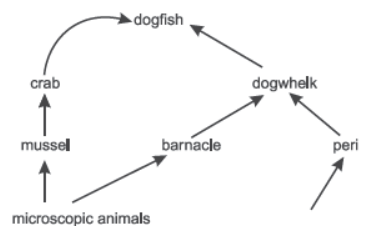
The mussel can be described as
(a) Producer
(b) Primary consumer
(c) Secondary consumer
(d) Decomposer
Answer
C
Question. Which of the following group of organisms are not included in ecological food chain?
(a) Carnivores
(b) Saprophytes
(c) Herbivores
(d) Predators
Answer
B
Class 10 Science Our Environment… Exam Questions
Question. List two items that can be easily recycled but we throw them in the dustbin.
Answer : Glass and plastic items can be easily recycled.
Question. State a way to prevent accumulation of harmful chemicals in our bodies.
Answer :To minimize use of pesticides in agriculture.
Question. During heavy rain in a village the rainwater carried excessive fertilizers to a pond. How will it affect the fish population in the pond in the long run?
Answer :The growth of fish will decrease as water gets polluted due to excessive algae growth.
Question. Write any two consequences if decomposers are removed from the ecosystem.
Answer :(i) Dead organisms will pile up.
(ii) There will be no replenishment of soil.
Question. State 10 percent law.
Answer : The energy available at any trophic level is only 10% of energy from previous trophic level.
Question. What will be the impact on ecosystems if bacteria,fungi/microorganism are removed from the environment?
Answer : Complex organic molecules will not breakdown into simple inorganic substances, preventing replenishment of soil.
Question. How is ozone layer important for human kind?
Answer : Ozone layer checks the entry of ultra violet rays of sun from reaching the earth. These rays otherwise can cause skin and blood cancer as well as defects in vision in human beings.
Question. A primary consumer in the food chain has 10000 J energy available. How much energy will be provided for tertiary consumer in this food chain?
Answer : 100 J.
Question. Name the two components of an ecosystem.
Answer : Biotic and abiotic are two components of an ecosystem.
Question. In a food chain of frog, grass, insect and snake, assign trophic level to frog.
Answer : Grass$ Insect$ Frog$ Snake
Frog is in 3rd trophic level i.e., secondary consumer.
Question. In a food chain of rabbit, grass and fox, assign trophic level to rabbit.
Answer : Grass$ rabbit$ fox
Rabbit is a primary consumer or a herbivore or 1st trophic level.
Question. Name two decomposers operating in our ecosystem.
Answer : Bacteria and fungi.
Question. How do bacteria and fungi able to decompose some of the wastes in our ecosystem?
Answer : Bacteria and fungi have enzymes to break down complex organic substances to simple and smaller ones.
Question. Which chemical is used in fire extinguishers? How is it harmful?
Answer : Fire extinguishers use Chlorofluorocarbons (CFCs). It depletes ozone layer.
Question. What are the two main components of our environment?
Answer : Two main components of our environment are:
a. Biotic (e.g., plants, animals etc.)
b. Abiotic (e.g., soil, air, water etc.)
Question. In a certain study conducted on occurrence of DDT along food chains in an ecosystem, the concentration of DDT in grass was found to be 0.5 ppm (parts per million), in sheep it was 2 ppm and in man it was 10 ppm. Why was the concentration of DDT maximum in case of man?
Answer : DDT is non-biodegradable substance which accumulates at each trophic level. Since man is at the highest trophic level, there is maximum accumulation of DDT in him (biological magnification).
Question. Ozone is deadly poisonous, still it performs an essential function. How?
Answer : Ozone layer shields the surface of the earth and blocks the entry of UV rays from the sun.
Question. What is depicted in the below mentioned scheme?
Answer : Food chain/10% law.
Question. Why are plastics non-biodegradable substances?
Answer : Plastics cannot be broken down by the action of enzymes/bacteria/saprophyte.
Question. What is meant non-biodegradable waste? Identify biodegradable waste from the following:
Empty packet of chips, empty plastic bottle of mineral water, empty paper box of sweets, empty tin of a cold drink.
Answer : Substances that do not break down by biological process are called non¬biodegradable waste. Empty paper box of sweets.
Question. Consider a food chain consisting of: wheat, rat, snakes, peacock: What will happen if all the snakes are killed?
Answer : If all snakes of food chain are killed the peacocks belonging to the next level will also die. Also the population of rats in the preceding level will highly increase.
Question. Choose one consumer each that belongs to the second and third trophic levels from the organisms given below:
Eagle, frog, tiger, rabbit, fox
Answer :
(i) Second trophic level$ Rabbit
(ii) Third trophic level$ Frog and fox.
Question. What happens during the first step of ozone formation in the atmosphere?
Answer : Oxygen in the presence of UV rays splits oxygen molecule into 2 oxygen atoms. (Image 55)
Question. Why are non-biodegradable substances not broken down by microbes?
Answer : Microbes are highly specific enzymes which can breakdown natural materials.
Question. What is an ecosystem?
Answer : Ecosystem is an interaction of physical and biotic factors present in an area among each other.
Question. Why is forest/lake considered a natural ecosystem?
Answer : Forests and lakes have both biotic and abiotic components which are present naturally and are interacting without man’s interference.
Question. If the energy available in phytoplanktons is 10,000 KJ, how much energy would a whale get on consuming them?
Answer : 1000 J.
Question. List two man-made ecosystems.
Answer : Aquarium, crop land, park are man made ecosystem.
Question. ‘Save the Tiger’ campaign is being over¬emphasised these days by our government. What may be the possible reason?
Answer : Tiger stands at the top trophic level. To maintain ecological balance in nature and to preserve gene pool.
Tiger is a threatened species. To help its survival, the Save the Tiger’ campaign is emphasized.
Question. When plants are eaten by primary consumers, a great deal of energy is lost as heat to the environment and some amount goes in carrying out various life processes. State the average percentage of energy lost in this manner.
Answer : 90%.
Short Answer Questions
Question. a. What is the height of ozone from the equator?
b. Name the rays against which ozone layer provides protection.
c. Name one effect of depletion of ozone.
Answer :
i. 10 to 16 km.
ii. UV rays.
iii. Global wanning.
Question. Within the school premises while playing some students observed that some people are burning dry leaves. They knew that it would cause harm to the environment. They immediately went and to these people requested them to stop it.
(i) How can the above activity be changed to make it environment friendly?
(ii) ‘Students took initiative to stop the practice’.
What values are displayed by them in this situation?
(iii) How can we spread awareness among people about being environment friendly?
Answer :
(i) Dry leaves can be put in the cojnpost pit to make manure.
(ii) Concern for environment, scientific temperament.
(iii) Counselling, posters, print and audio visual media.
Question. What is wild life? How is it important? How is it being protected by government of India?
Answer : Wild life means our flora and fauna. It is important: a. to preserve bio-diversity.
b. as each species has a position in the food chain so wildlife helps in balancing the nature.
Various species of plants and animals are preserved in botanical gardens, national parks, zoological parks and wildlife sanctuaries.
Question. List three environmental friendly practices which you would like to form a part of your daily habits giving justification for each.
Answer : Three environmental friendly activities are:
a. Should walk short distance to reduce use of vehicle running on fossil fuels.
b. Use both sides of papers to reduce its use. Less trees will be cut to make more paper.
c. Packing the gifts should not be practiced. It will reduce the use of shiny but non- biodegradable packing paper. Instead use the boxes and envelopes in which the gifts was received.
Question. State one important function of ozone layer in the atmosphere. How is it formed there? Which compounds are responsible for the depletion of ozone layer? How do these compounds enter into the atmosphere?
Answer : Ozone present in the upper regions of the atmosphere protects us from dangerous UV radiations.
Formation of ozone layer :
Ozone at the higher levels of the atmosphere is a product of UV radiations acting on oxygen (O2) molecule. The higher energy UV radiations split apart some molecular oxygen (O2) into free oxygen (O) atoms. These atoms then combine with the molecular oxygen to form ozone as shown: (Image 100)
Chlorofluorocarbons (CFCs) are responsible for the depletion of ozone layer. These compounds enter the atmosphere.
Question. State two advantages of conserving
(i) forests
(ii) wild life
Answer :
(i) Advantages of conserving forest are termed as ‘biodiversity hotspots’. They have large number of species of plants and animals.
(a) They purify air, help in recharging groundwater, bring rains and maintain the fertility of soil.
(b) They are also a source of income for tribal people.
(ii) Wild life is important
(a) To preserve bio-diversity.
(b) As each species has a position in the food chain so wildlife helps in balancing the nature.
Question. What are ozone holes? How do they form?
Answer : The coolants of Refrigerators and A/Cs use CFCs which release fluorine which react with ozone gas and break it into oxygen and a very reactive form of atomic oxygen which in turn can break another ozone molecule. Thus a chain reaction starts and layer of ozone becomes thinner at some places in upper atmosphere. These are called ozone holes.
Question. Distinguish between biodegradable , and nonbiodegradable substances. List two effects of each of them on our environment.
Answer :
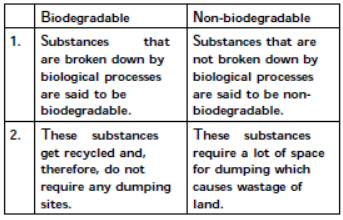
Effects of biodegradable substances:
a. They release harmful gases like methane, ammonia, carbon dioxide, hydrogen sulphide, etc., during decomposition process.
b. They release foul smell only during decomposition process but they do not cause any type of soil pollution.
Effects of non-biodegradable substances:
a. They persist in the environment for a long time and, thus, harm the various members of the ecosystem.
b. They release very harmful gases when they are acted upon by physical processes like heat and pressure.
c. They cause pollution of air, soil and water.
Question. Make an aquatic food chain up to tertiary consumer level. State the trophic level at which concentration of pesticide is maximum and why?
Answer :
Phytoplankton > Zooplankton -> Small fish > Bird.
Tertiary consumer, E.g., Bird.
Pesticides are not degradable and get progressively accumulated at each trophic level.
